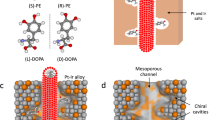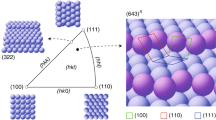Abstract
In the search for new materials and concepts in materials science, metallo-organic hybrids are attractive candidates; they can combine the rich diversity of organic molecules with the advantages of metals. Transition metals such as palladium are widely applied in catalysis, and small organic molecules such as those in the cinchona alkaloid family can control the stereochemistry of a number of organic reactions. Here, we show that reducing a metal salt in the presence of a cinchona alkaloid dopant gives a chirally imprinted metallo-organic hybrid material that is catalytically active and shows moderate enantioselectivity in hydrogenation. Furthermore, using photoelectron emission spectroscopy, we show that the metal retains some chiral character even after extraction of the dopant. This simple and effective methodology opens exciting opportunities for developing a variety of chiral composite materials.
This is a preview of subscription content, access via your institution
Access options
Subscribe to this journal
Receive 12 print issues and online access
$259.00 per year
only $21.58 per issue
Buy this article
- Purchase on Springer Link
- Instant access to full article PDF
Prices may be subject to local taxes which are calculated during checkout




Similar content being viewed by others
References
Callister W. D. Jr in Materials Science and Engineering: An Introduction 5th edn (Wiley, 2000).
Ball, P. in Made to Measure: New Materials for the 21st Century 4th edn (Princeton Univ. Press, 1999).
Behar-Levy, H. & Avnir, D. Entrapment of organic molecules within metals: Dyes in silver. Chem. Mater. 14, 1736–1741 (2002).
Nesher, G., Gad Marom, G. & Avnir, D. Metal-polymer composites: Synthesis and characterization of polyaniline and other polymer@silver compositions. Chem. Mater. 20, 4425–4432 (2008).
Yosef, I. & Avnir, D. Metal–organic composites: The heterogeneous organic doping of the coin metals—Copper, silver, and gold. Chem. Mater. 18, 5890–5896 (2006).
Behar-Levy, H. & Avnir, D. Silver doped with acidic/basic polymers: Novel, reactive metallic composites. Adv. Func. Mater. 15, 1141–1146 (2005).
Shter, G. E. et al. Organically doped metals—A new approach to metal catalysis: Enhanced Ag-catalyzed oxidation of methanol. Adv. Func. Mater. 17, 913–918 (2007).
Yosef, I., Abu-Reziq, R. & Avnir, D. Entrapment of an organometallic complex within a metal: A concept for heterogenous catalysis. J. Am. Chem. Soc. 130, 11880–11882 (2008).
Behar-Levy, H., Shter, G. E., Grader, G. S. & Avnir, D. Entrapment of organic molecules within metals 2. Polymers in silver. Chem. Mater. 16, 3197–3202 (2004).
Behar-Levy, H., Neumann, O., Naaman, R. & Avnir, D. Chirality induction in bulk gold and silver. Adv. Mater. 19, 1207–1211 (2007).
Goldsmith, M. R. et al. The chiroptical signature of achiral metal clusters induced by dissymmetric adsorbates. Phys. Chem. Chem. Phys. 8, 63–67 (2006).
Kacprzak, K. & Gawronski, J. Cinchona alkaloids and their derivatives: Versatile catalysts and ligands in asymmetric synthesis. Synthesis 961–998 (2001).
Heitbaum, M., Glorius, F. & Escher, I. Asymmetric heterogeneous catalysis. Angew. Chem. Int. Ed. 45, 4732–4762 (2006).
Ray, K., Ananthavel, S. P., Waldeck, D. H. & Naaman, R. Asymmetric scattering of polarized electrons by organized organic films of chiral molecules. Science, 283, 814–816 (1999).
Carmeli, I., Skakalova, V., Naaman, R. & Vager, Z. Magnetization of chiral monolayers of polypeptide: A possible source of magnetism in some biological membranes. Angew. Chem. Int. Ed. 41, 761–764 (2002).
Ray, S. G. et al. Chirality-induced spin-selective properties of self-assembled monolayers of DNA on gold. Phys. Rev. Lett. 96, 36–39 (2006).
Mukhopadhyay, P., Zuber, G., Wipf, P. & Beratan, D. N. Contribution of a solutés chiral solvent imprint to optical rotation. Angew. Chem. Int. Ed. 46, 6450–6452 (2007).
Yin, M. Y. et al. Asymmetric hydrogenation of ketones catalyzed by a silica-supported chitosan–palladium complex. J. Mol. Catal. A Chem. 147, 93–98 (1999).
Huck, W. R., Mallat, T. & Baiker, A. Heterogeneous enantioselective hydrogenation of 2-pyrones over cinchona-modified palladium. New J. Chem. 26, 6–8 (2002).
Huck, W. R., Mallat, T. & Baiker, A. Enantioselective hydrogenation of a methoxypyrone with cinchona-modified palladium. Catal. Lett. 80, 87–92 (2002).
Mhadgut, S. C., Török, M., Esquibel, J. & Török, B. Highly asymmetric heterogeneous catalytic hydrogenation of isophorone on proline modified base-supported palladium catalysts. J. Catal. 238, 441–448 (2006).
Tungler, A., Fodor, K., Máthé, T. & Sheldon, R. A. Enantioselective hydrogenation of ethyl pyruvate and isophorone over modified Pt and Pd catalysts. In Heterogeneous Catalysis and Fine Chemicals IV. Proc. 4th Int. Symp. on Heterogeneous Catalysis and Fine Chemicals, Basel, 8–12 September 1996. Studies in Surface Science and Catalysis Vol. 108 (eds Blaser, H.-U., Baiker, A., & Prins, R.) 157–165 (Elsevier, 1997).
Acknowledgements
G.R. and L.D.P. thank the Netherlands Organization for Scientific Research (NWO) for support via the Vernieuwingsimpuls programme. T.Z.M. and R.N. acknowledge the support of the Israel Science Foundation.
Author information
Authors and Affiliations
Corresponding author
Supplementary information
Supplementary information
Supplementary information (PDF 458 kb)
Rights and permissions
About this article
Cite this article
Durán Pachón, L., Yosef, I., Markus, T. et al. Chiral imprinting of palladium with cinchona alkaloids. Nature Chem 1, 160–164 (2009). https://doi.org/10.1038/nchem.180
Received:
Accepted:
Published:
Issue Date:
DOI: https://doi.org/10.1038/nchem.180
This article is cited by
-
Heteroepitaxial growth of Au@Pd core–shell nanocrystals with intrinsic chiral surfaces for enantiomeric recognition
Rare Metals (2024)
-
Biomimetic and bioorthogonal nanozymes for biomedical applications
Nano Convergence (2023)
-
Chiral molecular imprinting-based SERS detection strategy for absolute enantiomeric discrimination
Nature Communications (2022)
-
Nanoengineered chiral Pt-Ir alloys for high-performance enantioselective electrosynthesis
Nature Communications (2021)
-
Chiral metal surfaces for enantioselective processes
Nature Materials (2020)



